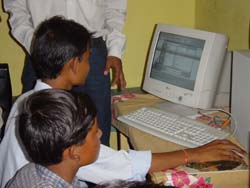|
ICTs for Sustainable
Livelihoods Ashok Khosla I n those segments of societies, which exist both in the industrialized and developing
nations, that have solved the basic problems of human survival and subsistence, Sustainable Development must mean improving the conditions of life. In the broadest sense of the term, it must mean attaining human fulfillment, nurturing body and soul and living in reasonable harmony with nature. There are many routes to achieving this and the literature on the subject is growing at a phenomenal pace. At a minimum, this requires considerable dematerialization in the normal course of day-to-day living, possibly by as much as a factor of ten. This also requires fundamental changes in production and trade systems, switching to the use of renewable resources, and increasingly adopting the new technologies emerging in such fields as information and communication, genetic engineering and miniaturization. And, in due course, they will require fundamental changes in what we mean by a good life and in our view of how much consumption is sufficient for attaining such a life.
The task for which Development Alternatives was set up, however, is not so much to preach a different way of life to the affluent but to find ways by which the poor can stand on their feet and claim a rightful place in the global economy – without adding to the destruction of Mother Earth already caused by the others. So, what can the term sustainable development mean for the poor and the marginalized? Or, for a country like India which has large numbers of them?
Quite simply, in most of the Third World, which happens to constitute the majority of the people living on this planet, sustainable development means satisfying two basic conditions: l To meet the basic needs of ALLl To maintain the health of the resource base And what is the most basic need of all? In our opinion, it is livelihoods —sustainable livelihoods. Sustainable livelihoods are jobs or activities that provide a reasonable income, produce goods and services needed in the local market, give meaning and dignity to life and at the same time conserve, as well as regenerate the environmental resource base. Having a sustainable livelihood enables any citizen to look after his or her basic needs. This not only leads to a stronger sense of self-reliance and citizenship, but also eliminates the need for dependency-creating poverty alleviation programs, inefficient subsidies and pork barrel corruption-generating projects. The creation of sustainable livelihood opportunities in large enough numbers is the single most important ingredient for bringing about sustainable national development.
And how does one create sustainable livelihoods in large numbers? This was the task that
Development Alternatives set out to address in 1983. We quickly realized that the complexity of the problem and the variety in the solutions needed required many different types of action, and over the years the organization grew into a conglomerate, the Development Alternatives Group, comprising not-for-profit institutions for research and design (Development Alternatives), for action, including production and marketing (TARA) and for advocacy (People First). For a more effective attack on specific issues, TARA set up specialized subsidiary companies such as DESI Power (for decentralized production and delivery of renewable-based energy), TARA Nirman Kendra (for supplying cost-effective and environmentally sound building materials) and TARAhaat (for ICT based services to village communities). The organizations of the Development Alternatives Group set out to address the three fundamental types of intervention available to society in reorienting its path in a more sustainable direction:
Converting society’s attention to the creation of sustainable livelihoods needs fundamental changes in all three types of intervention, from adopting sustainable consumption patterns and production systems to introducing economic incentives and setting up infrastructure. Development Alternatives and TARA have had considerable success in developing and marketing numerous "basic needs" or sustainable livelihood technologies throughout India. These include: l Construction technologies, including the TARA Balram to make Compressed Earth Blocks, the TARAcrete Unit to make Micro Concrete Roofing Tiles, the TARA Vertical Shaft Brick Kiln for fuel efficient baking of Bricks, the TARA Ferrocement Unit for making Roofing Channels, etc
Each of these technologies is designed to be the basis of village level enterprises, making and selling the products in the local market as well as for export to the city or overseas. To set up such enterprises and operate them profitably, the village entrepreneur needs access to a variety of supports. Some of the key factors of success are shown in the box. Currently, in most Third World economies, these supports do not exist at the village level. If they do, they are too expensive. The lack of these supports is, in fact, the critical missing link that prevents the proliferation of enterprise in many parts of the developing countries.
Traditionally grounded technologies of the type described above will not alone be sufficient to carry our people into their rightful place in the 21st Century. What are the other technologies that can help create sustainable livelihoods at the village level?
Certainly they must include the whole spectrum of cutting edge technologies, including ICTs, biotechnology, medical technologies and possibly even robotics and nanotechnologies. Here, we look at the implications of using information and communication technologies (ICT) as a sustainable development tool. ICTs come in many forms, and are concerned with the generation, storage, transmission and use of information. They come truly into their own when this information is transformed into knowledge that is useful for fulfilling the needs of people. ICTs have been around a long time (the printing press and the typewriter being among the earliest) and have had a profound effect in shaping the modern world. Starting with telegraph, telephone and radio, they have led successively to the television, electric typewriter, electronic calculator, fax machine, word processor, computer and the Internet. With the advent of each innovation, questions are invariably raised on the possible negative impact of the mechanization it brings on employment. And invariably there are two arguments on introducing it into the economy: those who feel that jobs will be lost by being replaced by machines, and those who argue that the additional jobs (usually of a higher intellectual content) created by the new technology will exceed the jobs lost, leading to a net addition in employment. How does ICT fit into this picture, for a developing country? Will the mobile phone, the computer, the Internet lead to more jobs for the poor or will these technologies marginalize them even further?
The answer lies not in the ICT sector itself but in the other economic sectors that availability of ICT can enable on a large scale. The number of jobs that ICT can create in remote or marginalized communities is significant, but limited at best. But the number of jobs that can be created in activities made possible because of the availability of better information facilities is pretty well unlimited. In this respect, ICT is second only to energy as an enabler of work and livelihoods. The work of TARAhaat, the ICT subsidiary of the Development Alternatives Group illustrates this perhaps better than any other example. Started in 2001, TARAhaat set out to provide information services to rural communities in to enable them to establish local enterprises as a means of creating sustainable livelihoods. In order to become financially viable, it quickly became a full-service Internet Portal, providing a host of web-based products including e-education, e-governance, e-mail and communication and is now entering the fields of telemedicine, e-commerce and other services. To provide affordable access to the Internet and through it to these services, TARAhaat is setting up a nationwide network of franchised cybercafes, the TARAkendras, which act as local community-cum-business centres at the village level. And fulfillment, i.e. physical delivery of products, is to be achieved through various courier services under development. In recognition of the fact that successful enterprises in the village will need all these services
just as much as industries in the city do, TARAhaat is establishing a special service for the village entrepreneur. Using the information and services available through its website, www.TARAhaat.com, and its on the ground support systems, including TARAkendras, TARAgurus (the barefoot consultants to advise on setting up and operating profitable enterprises) and www.TARAbazaar.com, the website to be set up for marketing village products to the outside world, it hopes to enable local enterprises quickly to become profitable. How many livelihoods will all this create? Each TARAkendra creates some two or three jobs directly for its own operations. In addition, it creates opportunities for one or two additional jobs for trainers, instructors, TARAgurus and other professionals. Thus some four to five jobs can at best be created by a single TARAkendra franchise. With, say, 20,000 TARAkendras dotted across the countryside (the number planned to be set up by TARAhaat over the next four or five years), we could imagine the creation of some 100,000 jobs – not a mean number but small in relation to the needs of a country like India which has to create about 15 million jobs a year. The rural industries enabled by TARAhaat, however, are a different story. A medium
sized village with a population of 10,000 could, in principle, sustain one TARAkendra plus four or five dozen technology based mini-enterprises. Such enterprises can only come into being and operate profitably provided the services of a TARAkendra-type service is available. Each enterprise, on average, would create 8 to 12 jobs. Thus, the existence of a TARAkendra in the village can, in principle, lead to the creation of some 500 jobs in such varied industries as oil-pressing, flour mills, construction materials, handlooms, briquetting, paper recycling, and others producing a host of products needed in the local market. With the same 20,000 TARAkendras, the number of jobs enabled by ICT could then approach some 10 million, a much more respectable figure.
Thus, it is obvious that ICT, judiciously used and with appropriately designed services offered through it, can be the catalyst of a very large number of livelihoods. Large investments are needed, not just in the creation of connectivity and bandwidth but much more in setting up the content, applications and services that enable enterprises to function successfully and people to lead fulfilling lives. q |
|||||||||||||||||||||||||||||||||||||||||||||||||||||||||||||||||||





